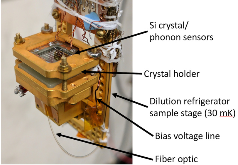Thermal detection of single e-h pairs in a biased silicon crystal detector
- Stanford Univ., CA (United States). Dept. of Physics
- SLAC National Accelerator Lab., Menlo Park, CA (United States). Kavli Inst.for Particle Astrophysics and Cosmology
- Stanford Univ., CA (United States). Dept. of Physics; SLAC National Accelerator Lab., Menlo Park, CA (United States). Kavli Inst.for Particle Astrophysics and Cosmology
- Univ. of California, Berkeley, CA (United States). Dept. of Physics
- Santa Clara Univ., Santa Clara, CA (United States). Dept. of Physics
We demonstrate that individual electron-hole pairs are resolved in a 1 cm2 by 4 mm thick silicon crystal (0.93 g) operated at ~35 mK. One side of the detector is patterned with two quasiparticle-trap-assisted electro-thermal-feedback transition edge sensor arrays held near ground potential. The other side contains a bias grid with 20% coverage. Bias potentials up to ±160 V were used in the work reported here. A fiber optic provides 650 nm (1.9 eV) photons that each produce an electron-hole (e–h+) pair in the crystal near the grid. The energy of the drifting charges is measured with a phonon sensor noise σ ~0.09 e– h+ pair. In conclusion, the observed charge quantization is nearly identical for h+s or e–s transported across the crystal.
- Research Organization:
- SLAC National Accelerator Laboratory (SLAC), Menlo Park, CA (United States)
- Sponsoring Organization:
- USDOE; National Science Foundation (NSF)
- Grant/Contract Number:
- AC02-76SF00515
- OSTI ID:
- 1424717
- Journal Information:
- Applied Physics Letters, Journal Name: Applied Physics Letters Journal Issue: 4 Vol. 112; ISSN 0003-6951
- Publisher:
- American Institute of Physics (AIP)Copyright Statement
- Country of Publication:
- United States
- Language:
- English
Similar Records
Superconductive pairing of fermions and semions in two dimensions




